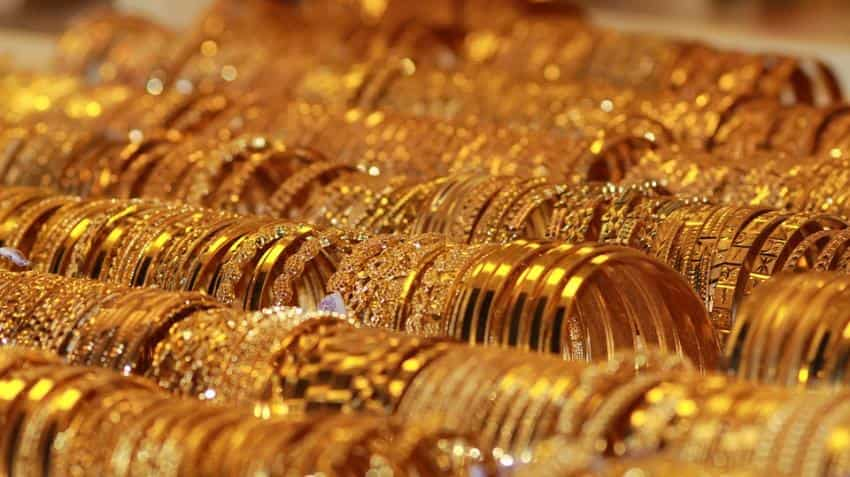Why buy physical gold when there are safer ways to invest?
Festive season is always considered as good time to invest in gold. Usually financial experts suggest that gold should not exceed 5 - 10% of one's portfolio.

Gold purchase in Diwali season has always been a tradition for Indians.
Owing to increased buying by local jewellers to meet festive demand, gold prices have surged at three-week high over Rs 31,000 per 10 grams - an uptick of Rs 290 compared to previous day prices.
Spot gold was also up 0.1% at $1,286.11 an ounce at 0350 GMT. It hit a one-week low of $1,281.31 in the previous session.
Interestingly, usually analysts guide for not keeping physical gold as an investment tool as it tends to lose the value in form of making charges - when it is being converted to the form of cash.
Usually, the loss from this conversion is seen anywhere between 15 - 20% on each jewellery.
Instead, there many other alternative and safer options which can be considered while making an investment in this precious metal.
Monthly Gold Investment Schemes:
Monthly investment schemes are now being offered by a number of jewellers. Investors can pay for the whole year and there variations for these too.
Under first variation, investors accumulated in the form of rupees and this can be redeemed as per the prevailing gold rate. Secondly - investors get to accumulate in grams and this is opted by many as one can take good advantage of the price fluctuations and it can be redeemed when the gold prices are high.
Gold Exchange-Traded Funds (ETFs):
This is considered as a mutual fund schem - which can be invested only in gold.
Units of gold are kept by investors in the electronic form. One unit of ETF is equivalent to one gram of gold or vice versa.
Minimum purchase of ETF can be made by 1 units. These units are traded on the stock exchange and one can buy or sell these similar to the ordinary shares.
Demand in this market has been lower as it has been witnessing outflows since past few fiscal years. Between April - September 2017, outflows stood at Rs 388 crore. While outflows of Rs 775 crore were recorded in FY17, Rs 903 crore in FY16, Rs 1,475 crore in FY15 and Rs 2,293 crore in FY14.
E-Gold:
Only difference between E-Gold and ETFs is that under E-Gold - an investor gets the opportunity to become the direct owner of a unit purchased while ETFs are owned by the asset management company who holds gold on the behalf of investors.
Gold Funds & Equity based gold funds:
Gold savings fund consists of simple investments. It is basically a mutual fund that invests in their Gold ETFs instead of regular ETFs.
Investors do not need to have a demat account to invest in gold funds as they can make their investment through SIPs.
Minimum investment required for Gold savings fund is Rs. 5000 which is a lump sum amount, initially and also additional purchase may be made of Rs 1000 and over Rs 1000 per month for 6 months in the case of an SIP.
There are many banks and financial institution who offer gold savings fund namely - Reliance Gold Savings Fund, Kotak Gold Fund, SBI Gold-Reg , ICICI Pru Regular Gold Savings Fund and Axis Gold Fund.
At the same time, investors can also consider equity based gold funds where investments are made on stocks that are issued by the companies involved in extraction, mining, marketing and processing of gold.
Gold Futures:
Gold futures are standardised, exchange-traded contracts in which the contract buyer agrees to take delivery, from the seller, a specific quantity of gold at a predetermined price on a future delivery date.
06:54 PM IST






 Delhi air pollution, noise levels lower than last Diwali: CPCB
Delhi air pollution, noise levels lower than last Diwali: CPCB To become rich soon, invest this Diwali money; 3 top ways you can benefit the most
To become rich soon, invest this Diwali money; 3 top ways you can benefit the most After PMC Bank crises this firm is in danger, turns agencies into action
After PMC Bank crises this firm is in danger, turns agencies into action Delhi air quality was worst at 3 a.m. on Diwali night
Delhi air quality was worst at 3 a.m. on Diwali night Less noisy Diwali in Agra, but pollution goes up
Less noisy Diwali in Agra, but pollution goes up